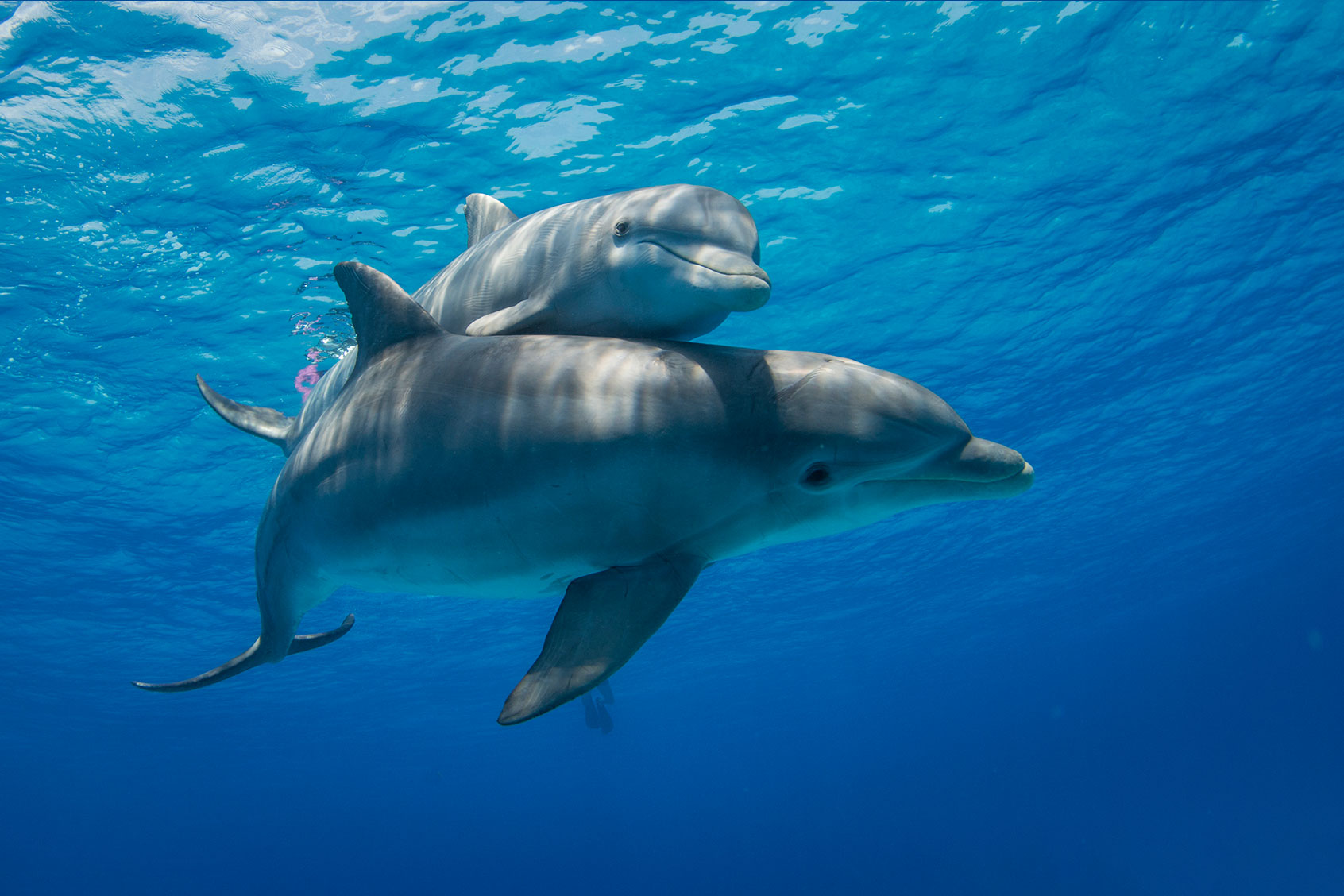Bottlenose dolphins possess impressive senses, not least of which is their bat-like ability to echolocate — or blast soundwaves to detect prey and other objects. Dolphins are also known for their highly developed sense of hearing, which allows them to process sound more rapidly, hear tones at high frequencies and communicate via a language of charming clicks. Their vision is uniquely adapted to see both in water and air. While there’s evidence that they can also taste, and are sensitive to touch (but likely not smell), a new study published in the Journal of Experimental Biology shows that they can feel electricity, too.
Called electroreception, the biological ability to perceive natural electrical stimuli is widespread in parts of the animal kingdom, especially among amphibians and fish. However, Guido Dehnhardt, a marine mammal zoologist and lead author of the study, said there are very few mammals that have this ability, with the platypus being a standout example. However, his latest discovery posits it could be more common than previously thought.
“The dolphins are the first true mammal known to have electroreception,” he told Salon. “And this can explain a lot.”
When bottlenose dolphins are born, they emerge with two rows of whiskers along their beak-like snouts which are similar to the whiskers that seals have that make them sensitive to touch. But in bottlenose dolphins, soon after birth, they lose their whiskers, which leaves behind dimples known as vibrissal crypts.
“The dolphins are the first true mammal known to have electroreception. And this can explain a lot.”
Only a decade ago did scientists begin to suspect that these dimples could be more than a relic of what once occupied space. Unlike the relic of a human being’s belly button, which is useless, the dimples of these dolphins could still have a purpose. Dehnhardt and his colleagues noticed the pits on the bottlenose dolphins looked a lot like ampullae on sharks, which are a line of small pores near their mouths that allow them to detect electric fields. Scientists believe sharks use this sense to find prey hidden under the sand by detecting their heartbeats. Could dolphins have this extraordinary sense, too?
In 2011, Dehnhardt studied the Guiana dolphin (Sotalia guianensis), a species native to the coasts of South America and concluded they do indeed have electroreception, which may help them dig for bottom-dwelling meals. "Our results show that electroreceptors can evolve from a mechanosensory organ that nearly all mammals possess and suggest the discovery of this kind of electroreception in more species, especially those with an aquatic or semi-aquatic lifestyle," he and his coauthors concluded. Today, bottlenose dolphins can also be added to the list, Dehnhardt said.
Want more health and science stories in your inbox? Subscribe to Salon's weekly newsletter Lab Notes.
Dehnhardt and his colleagues conducted their experiment with the help of two bottlenose dolphins named Donna and Dolly. First, they trained the dolphins to rest their jaws on a submerged metal bar, then to swim away within 5 seconds of feeling an electric field produced by electrodes above their snouts. The team of scientists gradually decreased the electric field and proceeded to keep track of how many times the dolphins ran away and see if they were sensitive to the electric field’s strength. It turned out that both were equally as sensitive to the strong stimulations.
"This sensory ability can also be used to explain the orientation of toothed whales to the earth’s magnetic field.”
As they became weaker, it became clear that Donna was more sensitive than Dolly. Next, the scientists moved on to see if the dolphins were sensitive to pulsing, like a heartbeat. Sure enough, the dolphins indicated that they could sense the pulsating electric fields. Like sharks, Dehnhardt said this ability in dolphins likely helps them search for food.
“The sensitivity to weak electric fields helps a dolphin search for fish hidden in sediment over the last few centimeters before snapping them up,” he said. "This sensory ability can also be used to explain the orientation of toothed whales to the earth’s magnetic field.”
Specifically, this could be the cause of mass stranding events, which is when dolphins wash ashore alive under abnormal circumstances, an unexplained behavior that often results in death. It’s long been suspected, Dehnhardt said, that dolphins are able to sense the Earth's magnetic field. Dehnhardt’s research states this is not that case. Dolphins don’t have a “pure magnetic sense,” but instead an electric sense. Still, this allows them to sense the magnetic field lines of the Earth, but also makes them possibly susceptible to getting lost.
We need your help to stay independent
“This field may change from time to time by changing ocean currents, for example, with an influence on the Earth's magnetic field, or by solar storms,” he said. “And if you are on your magnetic road, you read your map all the time, but someone you don’t know may have changed your map, you make a mistake, and you may end up at the beach.”
This means, he said, that for the first time scientists have the “sensory basis” to explain how electroreception can be used to detect the Earth’s magnetic fields, and what the implications of that are for mammals like bottlenose dolphins and mass stranding events.
“We have a new view of this phenomenon,” he said, adding that overall the new research shows that despite bottlenose dolphins being referred to as the “white rat” of cetology, there’s still a lot about these marine mammals that scientists don’t know.
“We still don’t know their entire sensorimotor system,” he said. “It's more complex than we saw before.
Read more
about the animal kingdom

